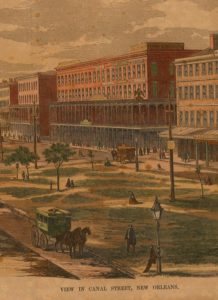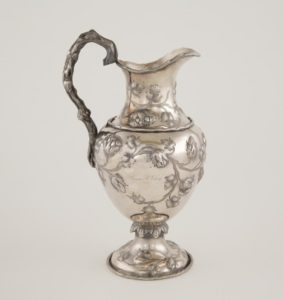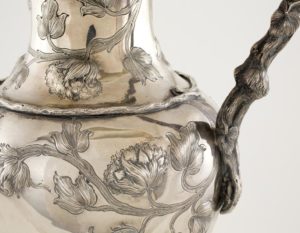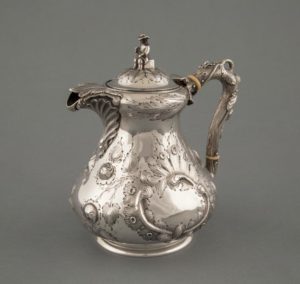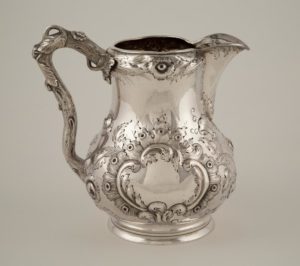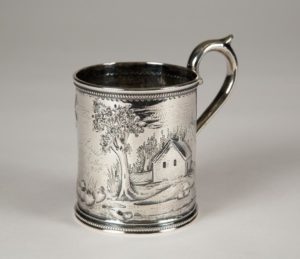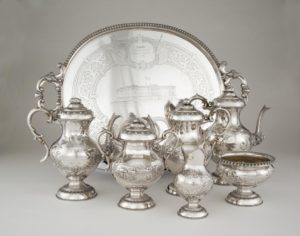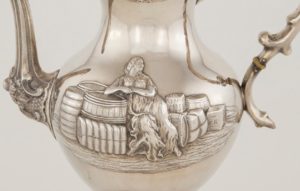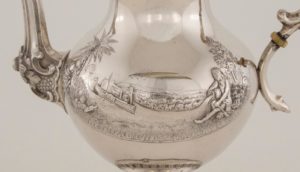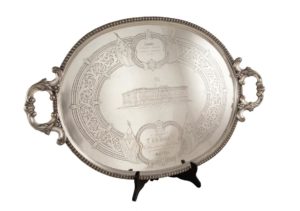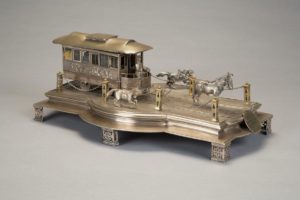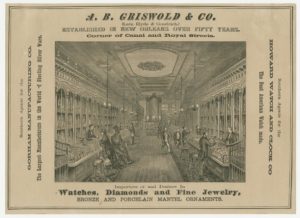Chasing Southern Dreams: Two Gentleman Silversmiths in New Orleans
Lydia Blackmore,
Decorative Arts Curator,
The Historic New Orleans Collection
A southern silver pitcher recently acquired by The Historic New Orleans Collection represents the artistry, skill, and assimilation of two German craftsmen in the Crescent City less than a decade before the Civil War (Figure 2). The coin silver pitcher stands tall, with a narrow neck, baluster body, and raised foot. Cast branches encircle the base, shoulder, and rim, while another branch curves up to form the handle of the piece. Repoussé stems wind around the body, punctuating it with fluffy bolls of cotton (Figure 3). The pitcher is a perfect expression of the antebellum South, reflecting agricultural wealth and Rococo aesthetics. It was purchased as a wedding gift from the most prominent jewelry store in New Orleans, and made by two highly skilled immigrant craftsmen quickly assimilating to life in the Gulf South. These silversmiths, Christoph Christian Küchler and Adolphe Himmel, produced some of the finest examples of New Orleans silver of the 1850s. Their careers overlapped and diverged as they found their way in the local market, intertwined through shared cultural heritage.
Arriving in New Orleans by 1852, German immigrants Küchler and Himmel found a city at the height of an economic boom. Located at the mouth of the Mississippi River, New Orleans was the second largest port in the country (Figure 4). The agricultural bounty of the South and Midwest flowed downriver, and finished goods in the latest style arrived on ships from around the world from the Gulf of Mexico. Cotton and sugar, grown using enslaved labor, made the city wealthy, and hotels, theaters, restaurants, and retail stores thrived. For the people of the Gulf South, New Orleans was the center of commerce, entertainment, and shopping.
The promise of wealth through agriculture or trade brought thousands of immigrants to New Orleans in the mid-19th century, including many people from German-speaking regions. Between 1820 and 1870, over 7.5 million German immigrants came to the United States, almost 1 million arriving through the port of New Orleans. By 1870, 20 percent of Louisiana’s population spoke German. Many of the German immigrants coming around 1850 were fleeing social unrest at home and sought political and religious freedom as well as economic opportunity in the United States. In 1847, the German Society of New Orleans formed to help immigrants acclimate to life in America. Many other German social organizations followed, creating a vibrant community in the Crescent City.1
Himmel was born in Bavaria in 1826 and left his homeland during political turmoil in 1848. According to a family story, Adolphe may have changed his surname to Himmel, the Saxon equivalent of a common name like “Smith,” to achieve anonymity when he emigrated. He possibly left Germany by way of France and then New York before arriving in New Orleans in the early 1850s. Himmel is first listed in the New Orleans city directory in 1852. He married Harriet Fellen, a French woman, at about the same time, and they had their first son, Adolphe Himmel Jr., the following year. The couple had at least three more children: Bertha (born 1861), Alvina (born 1868), and Frederick (born 1870). Harriet Fellen Himmel died in 1873, and her husband died a few years later.2
Küchler also first appeared in the New Orleans city directory in 1852. Like Himmel, Küchler’s names and their spelling vary by document, and very little is known about his life before New Orleans. He may have also immigrated to New Orleans from Germany by way of New York. Küchler married Wilhamina Schmidt, and they had their first son, Charles, in 1853. They had at least two other children: Jacob Oscar (born 1857) and Bertha (born 1861). Wilhelmina Küchler died in 1867 and is buried in New Orleans’s Greenwood Cemetery. The last record of Küchler’s work is in 1871, and he disappears from the documentary record thereafter.
In 1852, Küchler and Himmel were first listed in city directories together as a partnership of silver plate workers, located at 94 Old Basin Street. The recent immigrants were between 25 and 30 years old and may have decided to work together because of a shared language and training history. They must have completed an apprenticeship before they left Germany, perhaps finishing training in New York, because they were skilled silversmiths when they started working in New Orleans. Their partnership was short-lived, lasting from 1852–53, but they produced numerous pieces of high-quality silver in that brief time.3
The young silversmiths benefited from a relationship with the preeminent silver retailer Hyde & Goodrich, where they sold most of their work. Even after they parted ways, both silversmiths continued to manufacture pieces for the retailer. Hyde & Goodrich was founded in New Orleans by James Nevins Hyde and his brother-in-law Charles Whiting Goodrich by 1828. Both partners had connections to silversmith families in New York City and New England. In 1853, the firm moved into a prominent building on Canal Street, marked with a large golden pelican perched on the balcony (Figure 1). The firm’s store became a landmark on the major shopping avenue, where high-quality goods were readily available at a prime location, including imported silver flatware and hollowware, watches and jewelry, and even specialty guns to meet their Southern customers’ demands for luxury goods.4
Küchler & Himmel’s partnership with Hyde & Goodrich came at the perfect time. The mainstay of the retailer’s business had been selling silver manufactured in the Northeast, including pieces by New York producers Wood & Hughes, Tiffany, Young & Ellis, and Ball, Tomkins & Black; as well as Boston firms Jones, Ball & Poor, and Vincent Laforme & Brother (Figure 5). As Hyde & Goodrich planned to move to Canal Street, they sought to expand their inventory by offering custom, locally made pieces in the prevailing styles used by manufacturers in the Northeast. Küchler and Himmel, highly-trained silversmiths familiar with European and New York styles, were important players in the expansion of Hyde & Goodrich’s inventory.
Küchler and Himmel produced Rococo Revival silver with the same forms and designs as pieces imported from New York and Boston. They excelled at the typical tropes of the romantic style—cast branch handles, bold shell reserves on rounded bellies, and natural, asymmetric floral decoration (Figure 6). As local craftsmen, they were able to customize their fashionable work with inscriptions or design alterations to fit their customers’ needs. The cotton blossom pitcher, which was retailed by Hyde & Goodrich, is the epitome of their customization, an emblem of southern prosperity has not been found on pieces by the major northeastern manufacturers.
When Küchler and Himmel’s partnership broke up at the end of 1853, Himmel continued on very good terms with Hyde & Goodrich, producing hollowware exclusively for sale at the Canal Street store. Between 1853 and 1861, he produced hundreds of pieces for sale in Hyde & Goodrich’s ware rooms, primarily silver cups, mostly given as christening gifts, and water pitchers, which were popular wedding presents (Figure 7). He utilized interchangeable parts, such as cast handles, milled borders, and rolled sheets of coin silver, to produce custom silver relatively quickly. Close study of his work shows an even hand at engraving and the ability to replicate foliate scenes using simple chasing tools (Figure 8).
After he split from the partnership with Himmel, Küchler worked on his own for several years. He did some work for Hyde & Goodrich, possibly even working with his old partner on some commissions, but he also made objects for other retailers or without any retail mark. There is far less physical evidence of Küchler’s career in the mid-1850s than Himmel’s, but the few pieces found in museum collections and at auction show his mastery of weight and shadow in engraving and repoussé work.
In 1858, Küchler partnered with Bernard Terfloth, another German silversmith who immigrated to New Orleans as a young man just after 1850. They formed the firm Terfloth & Küchler on Customhouse (now Iberville) Street. The partners were listed as jewelers and silversmiths in the city directories for the next few years. They produced very fine silver, mostly for presentation purposes, building on Küchler’s craftsmanship, with the addition of Terfloth’s business connections. None of their known work is marked by additional retailers.
The finest example of Terfloth & Küchler’s work and, arguably, of all New Orleans-made silver, is the monumental tea and coffee service presented to Francis Hanson Hatch, Collector of the Port of New Orleans on the eve of the Civil War. The set composes a hot water pot, coffeepot, teapot, covered sugar bowl, waste bowl, cream pitcher, and a large tray. Each piece features unique decoration, topped with finials in the shapes of fruits grown in the South, and accented with scroll handles and elongated egg and dart molding (Figure 9).
The decoration on each component follows the theme of trade in New Orleans. On the hot water pot, the female personification of Commerce lounges amongst the many shipping containers that could be found on the levees at the Port of New Orleans. She leans on bales of cotton and hogsheads of other agricultural exports to her left, looking to the bundles, barrels, and crates of imported goods on her right. One of the crates has Chinese characters around the sides, indicating the wide reach of New Orleans commerce. Another box is signed “Care C K,” for the maker, Christian Küchler (Figure 10).
The next piece in size, the coffeepot, shows a view of New Orleans on the Mississippi River, with the spire of St. Louis Cathedral among the recognizable landmarks. The teapot has a mythical version of this view, showing the Father of Waters pouring out the Mississippi from his jar (Figure 11). He sits in an Eden-like setting while the river he dispenses ventures south toward the tropical flora and fauna of Louisiana, including a palm tree and an alligator.
The sugar bowl is appropriately decorated with a Louisiana sugar plantation, showing a grand house sitting amongst fields, with a sugar mill in the background and a locomotive in the foreground. Symbols of industry and agriculture decorate the smaller faces of the waste bowl and cream pitcher. Each piece bears the inscription: “Presented to F. H. Hatch, Collector of the Port of New Orleans by his Friends in the Custom House. May 1st, 1861” and the mark “Terfloth & Küchler/ New Orleans” (Figure 12).
The final piece of the Hatch presentation service is a large silver tray bearing a precise engraving of the New Orleans Custom House (Figure 13). As Collector of the Port of New Orleans, the Custom House was Hatch’s domain. Hatch was appointed to his position by President James Buchanan in 1857. When Louisiana seceded from the Union on January 26, 1861, Hatch went with it, continuing in his position for the Confederacy. The turbulent politics of the time are evident in the flags flanking the inscription on the tray. One flag has a single star in the canton next to thirteen stripes, which is the flag of Independent Louisiana, flown between January 26, 1861, when Louisiana seceded from the Union, and March 21, 1861, when it officially joined the Confederate States of America. The other flag is the original “Stars and Bars” flag of the CSA, with seven stars, representing the first seven states to secede. The flags on the tray, and the entire Hatch service, mark a pinpoint in time, documenting the peak of Louisiana commerce on the eve of the Civil War. The intricate chasing and engraving also represent the apex of Küchler’s artistry in silver.
Terfloth & Küchler were listed together for the final time in the 1861 city directory. The last record of Küchler is in an advertisement for C. H. Zimmermann & Co. in 1871, including the line “Mr. Christian Küchler has charge of the Silverware Manufactory” where presentation silver could be made to order.5 Küchler took charge of the Zimmermann manufactory at the height of its business. A silver model of a Canal Street streetcar produced at Zimmermann’s silver manufactory circa 1870 may be the last known piece of silver related to Küchler’s career (Figure 14). Zimmermann’s closed in 1875 following the owner’s suicide. There is no further record of Küchler’s presence in New Orleans.
Unlike Küchler, Himmel ended his career on a high note. When Hyde & Goodrich became A. B. Griswold & Company after the Civil War, Himmel headed their silver manufactory (Figure 15).6 In 1869, with a hefty loan from his former employers, Himmel started his own silverware manufactory on Poydras Street. In his new steam-powered factory, Himmel produced silver in the styles of the 1870s. He also expanded his manufacturing to more practical goods, producing headlights for locomotives and steamboats, and reflective lamps for use in sugarcane sheds and other agricultural work.
Adolphe Himmel died on August 21, 1877. He was 51 years old and had been making beautiful goods in New Orleans for half his life. Two days after his passing, the New Orleans Times lamented: “By the death of this estimable man… New Orleans has lost one of its most enterprising and industrious citizens. A pioneer in this locality in the manufacture of silverware, he opened a new source of profit to our mechanics and labored hard to develop it to the extent that it deserved. Quiet and unobtrusive, true to all his obligations and pure in his life, he was an example of modest worth, which we hope will not be forgotten.”7
In the decade before the Civil War, Küchler and Himmel produced silver that embodied the wealth and romance of the Dixie elite. Following the war, they turned to technology for their inspiration and craftsmanship. Throughout that time, they found a welcoming German community in which they formed business and personal relationships. Their work is a lasting testament of their artistic skill and their assimilation into Southern culture.
1
“Sources for the Study of Germans in Louisiana and New Orleans at the Williams Research Center,” The Historic New Orleans Collection, accessed June 1, 2018, https://www.hnoc.org/research/sources-study-germans-louisiana-and-new-orleans-williams-research-center.
2
Personal and business facts throughout this paper have been gleaned from many sources increasingly available through digitization efforts. Ancestry.com has been a wonderful resource, providing access to digitized birth, marriage, and death records and even wills, probate inventories, and succession papers. All of the New Orleans City Directories following the Civil War are available through that source as well. Directories prior to the war are available in the periodical collection at The Historic New Orleans Collection. Newspaper databases, such as America’s Historical Newspapers and Chronicling America (Library of Congress), have made the advertising history of these craftsmen and retailers available through simple searches of decades of publications.
3
Pieces from the partnership are included in collections across the Gulf South, including the LSU Museum of Art, New Orleans Museum of Art, and The Historic New Orleans Collection. Many thanks to Neal Auctions for their archive of past auctions.
4
A summary of the retail history of Hyde & Goodrich, as well as many other major New Orleans Retailers, was presented in the exhibition Goods of Every Description: Shopping in New Orleans, 1825–1925 at The Historic New Orleans Collection, Sept. 2016 – April 2017, now preserved in virtual form on the museum website.
5
Advertisement, New Orleans Republican, March 2, 1871, p.7; Chronicling America, Library of Congress.
6
Hyde & Goodrich became Thomas Griswold & Company during the Civil War, producing weapons for the Confederate Army. The manufactory was shut down after the Union occupation of New Orleans. After the war, the firm reopened under the name A. B. Griswold & Co. and continued their successful business selling silver and jewelry on Canal Street.
7
“Mr. A. Himmel,” New Orleans Times, August 23, 1877, p. 1; America’s Historical Newspapers.
Lydia Blackmore,
Decorative Arts Curator,
The Historic New Orleans Collection
A southern silver pitcher recently acquired by The Historic New Orleans Collection represents the artistry, skill, and assimilation of two German craftsmen in the Crescent City less than a decade before the Civil War (Figure 2). The coin silver pitcher stands tall, with a narrow neck, baluster body, and raised foot. Cast branches encircle the base, shoulder, and rim, while another branch curves up to form the handle of the piece. Repoussé stems wind around the body, punctuating it with fluffy bolls of cotton (Figure 3). The pitcher is a perfect expression of the antebellum South, reflecting agricultural wealth and Rococo aesthetics. It was purchased as a wedding gift from the most prominent jewelry store in New Orleans, and made by two highly skilled immigrant craftsmen quickly assimilating to life in the Gulf South. These silversmiths, Christoph Christian Küchler and Adolphe Himmel, produced some of the finest examples of New Orleans silver of the 1850s. Their careers overlapped and diverged as they found their way in the local market, intertwined through shared cultural heritage.
Arriving in New Orleans by 1852, German immigrants Küchler and Himmel found a city at the height of an economic boom. Located at the mouth of the Mississippi River, New Orleans was the second largest port in the country (Figure 4). The agricultural bounty of the South and Midwest flowed downriver, and finished goods in the latest style arrived on ships from around the world from the Gulf of Mexico. Cotton and sugar, grown using enslaved labor, made the city wealthy, and hotels, theaters, restaurants, and retail stores thrived. For the people of the Gulf South, New Orleans was the center of commerce, entertainment, and shopping.
The promise of wealth through agriculture or trade brought thousands of immigrants to New Orleans in the mid-19th century, including many people from German-speaking regions. Between 1820 and 1870, over 7.5 million German immigrants came to the United States, almost 1 million arriving through the port of New Orleans. By 1870, 20 percent of Louisiana’s population spoke German. Many of the German immigrants coming around 1850 were fleeing social unrest at home and sought political and religious freedom as well as economic opportunity in the United States. In 1847, the German Society of New Orleans formed to help immigrants acclimate to life in America. Many other German social organizations followed, creating a vibrant community in the Crescent City.1
Himmel was born in Bavaria in 1826 and left his homeland during political turmoil in 1848. According to a family story, Adolphe may have changed his surname to Himmel, the Saxon equivalent of a common name like “Smith,” to achieve anonymity when he emigrated. He possibly left Germany by way of France and then New York before arriving in New Orleans in the early 1850s. Himmel is first listed in the New Orleans city directory in 1852. He married Harriet Fellen, a French woman, at about the same time, and they had their first son, Adolphe Himmel Jr., the following year. The couple had at least three more children: Bertha (born 1861), Alvina (born 1868), and Frederick (born 1870). Harriet Fellen Himmel died in 1873, and her husband died a few years later.2
Küchler also first appeared in the New Orleans city directory in 1852. Like Himmel, Küchler’s names and their spelling vary by document, and very little is known about his life before New Orleans. He may have also immigrated to New Orleans from Germany by way of New York. Küchler married Wilhamina Schmidt, and they had their first son, Charles, in 1853. They had at least two other children: Jacob Oscar (born 1857) and Bertha (born 1861). Wilhelmina Küchler died in 1867 and is buried in New Orleans’s Greenwood Cemetery. The last record of Küchler’s work is in 1871, and he disappears from the documentary record thereafter.
In 1852, Küchler and Himmel were first listed in city directories together as a partnership of silver plate workers, located at 94 Old Basin Street. The recent immigrants were between 25 and 30 years old and may have decided to work together because of a shared language and training history. They must have completed an apprenticeship before they left Germany, perhaps finishing training in New York, because they were skilled silversmiths when they started working in New Orleans. Their partnership was short-lived, lasting from 1852–53, but they produced numerous pieces of high-quality silver in that brief time.3
The young silversmiths benefited from a relationship with the preeminent silver retailer Hyde & Goodrich, where they sold most of their work. Even after they parted ways, both silversmiths continued to manufacture pieces for the retailer. Hyde & Goodrich was founded in New Orleans by James Nevins Hyde and his brother-in-law Charles Whiting Goodrich by 1828. Both partners had connections to silversmith families in New York City and New England. In 1853, the firm moved into a prominent building on Canal Street, marked with a large golden pelican perched on the balcony (Figure 1). The firm’s store became a landmark on the major shopping avenue, where high-quality goods were readily available at a prime location, including imported silver flatware and hollowware, watches and jewelry, and even specialty guns to meet their Southern customers’ demands for luxury goods.4
Küchler & Himmel’s partnership with Hyde & Goodrich came at the perfect time. The mainstay of the retailer’s business had been selling silver manufactured in the Northeast, including pieces by New York producers Wood & Hughes, Tiffany, Young & Ellis, and Ball, Tomkins & Black; as well as Boston firms Jones, Ball & Poor, and Vincent Laforme & Brother (Figure 5). As Hyde & Goodrich planned to move to Canal Street, they sought to expand their inventory by offering custom, locally made pieces in the prevailing styles used by manufacturers in the Northeast. Küchler and Himmel, highly-trained silversmiths familiar with European and New York styles, were important players in the expansion of Hyde & Goodrich’s inventory.
Küchler and Himmel produced Rococo Revival silver with the same forms and designs as pieces imported from New York and Boston. They excelled at the typical tropes of the romantic style—cast branch handles, bold shell reserves on rounded bellies, and natural, asymmetric floral decoration (Figure 6). As local craftsmen, they were able to customize their fashionable work with inscriptions or design alterations to fit their customers’ needs. The cotton blossom pitcher, which was retailed by Hyde & Goodrich, is the epitome of their customization, an emblem of southern prosperity has not been found on pieces by the major northeastern manufacturers.
When Küchler and Himmel’s partnership broke up at the end of 1853, Himmel continued on very good terms with Hyde & Goodrich, producing hollowware exclusively for sale at the Canal Street store. Between 1853 and 1861, he produced hundreds of pieces for sale in Hyde & Goodrich’s ware rooms, primarily silver cups, mostly given as christening gifts, and water pitchers, which were popular wedding presents (Figure 7). He utilized interchangeable parts, such as cast handles, milled borders, and rolled sheets of coin silver, to produce custom silver relatively quickly. Close study of his work shows an even hand at engraving and the ability to replicate foliate scenes using simple chasing tools (Figure 8).
After he split from the partnership with Himmel, Küchler worked on his own for several years. He did some work for Hyde & Goodrich, possibly even working with his old partner on some commissions, but he also made objects for other retailers or without any retail mark. There is far less physical evidence of Küchler’s career in the mid-1850s than Himmel’s, but the few pieces found in museum collections and at auction show his mastery of weight and shadow in engraving and repoussé work.
In 1858, Küchler partnered with Bernard Terfloth, another German silversmith who immigrated to New Orleans as a young man just after 1850. They formed the firm Terfloth & Küchler on Customhouse (now Iberville) Street. The partners were listed as jewelers and silversmiths in the city directories for the next few years. They produced very fine silver, mostly for presentation purposes, building on Küchler’s craftsmanship, with the addition of Terfloth’s business connections. None of their known work is marked by additional retailers.
The finest example of Terfloth & Küchler’s work and, arguably, of all New Orleans-made silver, is the monumental tea and coffee service presented to Francis Hanson Hatch, Collector of the Port of New Orleans on the eve of the Civil War. The set composes a hot water pot, coffeepot, teapot, covered sugar bowl, waste bowl, cream pitcher, and a large tray. Each piece features unique decoration, topped with finials in the shapes of fruits grown in the South, and accented with scroll handles and elongated egg and dart molding (Figure 9).
The decoration on each component follows the theme of trade in New Orleans. On the hot water pot, the female personification of Commerce lounges amongst the many shipping containers that could be found on the levees at the Port of New Orleans. She leans on bales of cotton and hogsheads of other agricultural exports to her left, looking to the bundles, barrels, and crates of imported goods on her right. One of the crates has Chinese characters around the sides, indicating the wide reach of New Orleans commerce. Another box is signed “Care C K,” for the maker, Christian Küchler (Figure 10).
The next piece in size, the coffeepot, shows a view of New Orleans on the Mississippi River, with the spire of St. Louis Cathedral among the recognizable landmarks. The teapot has a mythical version of this view, showing the Father of Waters pouring out the Mississippi from his jar (Figure 11). He sits in an Eden-like setting while the river he dispenses ventures south toward the tropical flora and fauna of Louisiana, including a palm tree and an alligator.
The sugar bowl is appropriately decorated with a Louisiana sugar plantation, showing a grand house sitting amongst fields, with a sugar mill in the background and a locomotive in the foreground. Symbols of industry and agriculture decorate the smaller faces of the waste bowl and cream pitcher. Each piece bears the inscription: “Presented to F. H. Hatch, Collector of the Port of New Orleans by his Friends in the Custom House. May 1st, 1861” and the mark “Terfloth & Küchler/ New Orleans” (Figure 12).
The final piece of the Hatch presentation service is a large silver tray bearing a precise engraving of the New Orleans Custom House (Figure 13). As Collector of the Port of New Orleans, the Custom House was Hatch’s domain. Hatch was appointed to his position by President James Buchanan in 1857. When Louisiana seceded from the Union on January 26, 1861, Hatch went with it, continuing in his position for the Confederacy. The turbulent politics of the time are evident in the flags flanking the inscription on the tray. One flag has a single star in the canton next to thirteen stripes, which is the flag of Independent Louisiana, flown between January 26, 1861, when Louisiana seceded from the Union, and March 21, 1861, when it officially joined the Confederate States of America. The other flag is the original “Stars and Bars” flag of the CSA, with seven stars, representing the first seven states to secede. The flags on the tray, and the entire Hatch service, mark a pinpoint in time, documenting the peak of Louisiana commerce on the eve of the Civil War. The intricate chasing and engraving also represent the apex of Küchler’s artistry in silver.
Terfloth & Küchler were listed together for the final time in the 1861 city directory. The last record of Küchler is in an advertisement for C. H. Zimmermann & Co. in 1871, including the line “Mr. Christian Küchler has charge of the Silverware Manufactory” where presentation silver could be made to order.5 Küchler took charge of the Zimmermann manufactory at the height of its business. A silver model of a Canal Street streetcar produced at Zimmermann’s silver manufactory circa 1870 may be the last known piece of silver related to Küchler’s career (Figure 14). Zimmermann’s closed in 1875 following the owner’s suicide. There is no further record of Küchler’s presence in New Orleans.
Unlike Küchler, Himmel ended his career on a high note. When Hyde & Goodrich became A. B. Griswold & Company after the Civil War, Himmel headed their silver manufactory (Figure 15).6 In 1869, with a hefty loan from his former employers, Himmel started his own silverware manufactory on Poydras Street. In his new steam-powered factory, Himmel produced silver in the styles of the 1870s. He also expanded his manufacturing to more practical goods, producing headlights for locomotives and steamboats, and reflective lamps for use in sugarcane sheds and other agricultural work.
Adolphe Himmel died on August 21, 1877. He was 51 years old and had been making beautiful goods in New Orleans for half his life. Two days after his passing, the New Orleans Times lamented: “By the death of this estimable man… New Orleans has lost one of its most enterprising and industrious citizens. A pioneer in this locality in the manufacture of silverware, he opened a new source of profit to our mechanics and labored hard to develop it to the extent that it deserved. Quiet and unobtrusive, true to all his obligations and pure in his life, he was an example of modest worth, which we hope will not be forgotten.”7
In the decade before the Civil War, Küchler and Himmel produced silver that embodied the wealth and romance of the Dixie elite. Following the war, they turned to technology for their inspiration and craftsmanship. Throughout that time, they found a welcoming German community in which they formed business and personal relationships. Their work is a lasting testament of their artistic skill and their assimilation into Southern culture.
1
“Sources for the Study of Germans in Louisiana and New Orleans at the Williams Research Center,” The Historic New Orleans Collection, accessed June 1, 2018, https://www.hnoc.org/research/sources-study-germans-louisiana-and-new-orleans-williams-research-center.
2
Personal and business facts throughout this paper have been gleaned from many sources increasingly available through digitization efforts. Ancestry.com has been a wonderful resource, providing access to digitized birth, marriage, and death records and even wills, probate inventories, and succession papers. All of the New Orleans City Directories following the Civil War are available through that source as well. Directories prior to the war are available in the periodical collection at The Historic New Orleans Collection. Newspaper databases, such as America’s Historical Newspapers and Chronicling America (Library of Congress), have made the advertising history of these craftsmen and retailers available through simple searches of decades of publications.
3
Pieces from the partnership are included in collections across the Gulf South, including the LSU Museum of Art, New Orleans Museum of Art, and The Historic New Orleans Collection. Many thanks to Neal Auctions for their archive of past auctions.
4
A summary of the retail history of Hyde & Goodrich, as well as many other major New Orleans Retailers, was presented in the exhibition Goods of Every Description: Shopping in New Orleans, 1825–1925 at The Historic New Orleans Collection, Sept. 2016 – April 2017, now preserved in virtual form on the museum website.
5
Advertisement, New Orleans Republican, March 2, 1871, p.7; Chronicling America, Library of Congress.
6
Hyde & Goodrich became Thomas Griswold & Company during the Civil War, producing weapons for the Confederate Army. The manufactory was shut down after the Union occupation of New Orleans. After the war, the firm reopened under the name A. B. Griswold & Co. and continued their successful business selling silver and jewelry on Canal Street.
7
“Mr. A. Himmel,” New Orleans Times, August 23, 1877, p. 1; America’s Historical Newspapers.

